|
The
|
THE BURGENLAND BUNCH NEWS - No. 231 April 30, 2013, © 2013 by The Burgenland Bunch All rights reserved. Permission to copy excerpts granted if credit is provided. Editor: Thomas Steichen (email: tj.steichen@comcast.net) Our 17th Year. The Burgenland Bunch Newsletter is issued monthly online. It was founded by Gerald Berghold (who retired Summer 2008 and died in August 2008). |
Current Status Of The BB: * Members: 2149 * Surname Entries: 7184 * Query Board Entries: 5115 * Staff Members: 17 |
This newsletter concerns: 1) THE PRESIDENT'S CORNER 2) MARIA HOFFMANN HOTWAGNER 3) A SALZBURG TO BURGENLAND CONNECTION? 4) THE BRIDGE AT ANDAU (by Hannes Graf) 5) MORE ACCESS RESTRICTIONS FOR US VITAL RECORDS? 6) HISTORICAL BB NEWSLETTER ARTICLES: - BURGENLÄNDERS WHO WENT WEST! (from Lynette Wolf) 7) ETHNIC EVENTS 8) BURGENLAND EMIGRANT OBITUARIES (courtesy of Bob Strauch) |
1) THE PRESIDENT'S CORNER (by Tom Steichen)  Concerning
this newsletter, after the Bits and Pieces in my President's
Corner below, we get down to full length articles starting with one about Maria
Hoffmann Hotwagner and her family. Maria is the aunt of Walter F Hoffman and the
subject of research by Florence ("Beebe") Hoffman, Walter's wife. Beebe is looking for Maria's
death date, but the extended story is so interesting (and so sad) that I had to write it up...
see for yourself. Our second article asks whether there was a Salzburg To Burgenland
Connection, in particular, a connection at the time of the 1732 expulsion of Salzburg
Lutherans. The last two articles are an accounting by Hannes Graf of
Burgenland's Bridge at Andau, which gained fame due to its role in the 1956
Hungarian uprising against the Communists, and a discussion, by me, of whether there will be
More Access Restrictions placed on US Vital Records. Concerning
this newsletter, after the Bits and Pieces in my President's
Corner below, we get down to full length articles starting with one about Maria
Hoffmann Hotwagner and her family. Maria is the aunt of Walter F Hoffman and the
subject of research by Florence ("Beebe") Hoffman, Walter's wife. Beebe is looking for Maria's
death date, but the extended story is so interesting (and so sad) that I had to write it up...
see for yourself. Our second article asks whether there was a Salzburg To Burgenland
Connection, in particular, a connection at the time of the 1732 expulsion of Salzburg
Lutherans. The last two articles are an accounting by Hannes Graf of
Burgenland's Bridge at Andau, which gained fame due to its role in the 1956
Hungarian uprising against the Communists, and a discussion, by me, of whether there will be
More Access Restrictions placed on US Vital Records.The remaining articles are our standard sections: Historical Newsletter Articles, and the Ethnic Events and Emigrant Obituaries sections. This month we report an obituary that cuts close to our BB core: Anna (Sucher) Potetz, the mother of Richard Potetz, a frequent BB contributor, joins our honor roll of Burgenland-born, American-deceased emigrants. Our sympathies go out to Richard. But I start with some bits and pieces: After publishing last month's article on Availability of Burgenland Records, I stumbled across the following in Newsletter No. 18, from 31 Aug 1997, which gives more detail about availability (or not) of some of the earliest records: LOCATION OF OLDER BURGENLAND RECORDS (By Gerry Berghold) Having seen older church visitation and aristocratic family records surface in various places, I asked Albert Schuch if he knew where some of the originals were archived and whether they had all been translated. His reply follows: Visitationen - The script originals are kept in the Diözesanarchiv Eisenstadt (1757) and somewhere in Hungary, I think in Steinamanger (Szombathely) (1697). A few others have also appeared in print, but mostly for the northern regions of Burgenland. In general, very few of the old script documents have been transcribed. So they can only be used in the archives. (Most scientific works based on archive material do not mention many names, so they are of little genealogical value.) Esterházy Archives - Parts of the Esterházy archives are kept in the Forchtenstein castle. I have never been there and I have heard that it is very difficult to get access to the archive. It is, after all, private property. Other parts of Esterházy archives are kept in the Hungarian National Archives in Budapest. Parts have been microfilmed for the Burgenländisches Landesarchiv in Eisenstadt. Batthyány Archives - The Batthyány archives for the domains of Schlaining, Pinkafeld and Kittsee are kept in the Burgenländisches Landesarchiv, so they are quite easy to access. I have seen parts of them for my masters thesis. It is more difficult to get access to the Herrschaftsarchiv Güssing in the Güssing castle. I think right now it is almost impossible. The Batthyány archives of Körmend have been transferred to Budapest, so they are part of the Hungarian National Archives today. Again, parts have been microfilmed for the Landesarchiv. Availability of the church records - Those which are kept in Eisenstadt in the Diözesanarchiv are in theory open to the public. But you have to make an appointment. VERY little space there, so they won't wish to attract many people. I was there a few months ago, but only to check which books they kept there and which were in the parishes (for a few villages). I will be able to tell you more about the Diözesanarchiv in a few weeks, since I plan to look for leather workers in the church records of two parishes some time in August. - As regards the records kept in the parishes, I guess you are more or less at the mercy of the local priest. (Ed. note: again, copies of records from 1828, the basis of the LDS Salt Lake City microfilm collection, are in the Hungarian National Archives in Budapest.) 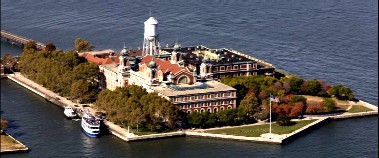 Ellis
Island and Superstorm Sandy: As you may know, the Ellis Island Immigration Museum
sustained severe damage to its infrastructure by late October's Superstorm Sandy. The
main problem was that the storm surge covered the island with up to 8 feet of water,
destroying boilers and electrical systems. Unlike Liberty Island, which is scheduled to be
reopened on July 4th, Ellis Island is not expected to reopen to the public this year. As of
late March, Ellis Island was still without power and heat, which has caused continuing damage
to the building. Reopening it to the public will be a multi-step process according to the
National Park Service. This includes getting power back, restoring the physical condition of
the building and then returning the museum contents. Ellis
Island and Superstorm Sandy: As you may know, the Ellis Island Immigration Museum
sustained severe damage to its infrastructure by late October's Superstorm Sandy. The
main problem was that the storm surge covered the island with up to 8 feet of water,
destroying boilers and electrical systems. Unlike Liberty Island, which is scheduled to be
reopened on July 4th, Ellis Island is not expected to reopen to the public this year. As of
late March, Ellis Island was still without power and heat, which has caused continuing damage
to the building. Reopening it to the public will be a multi-step process according to the
National Park Service. This includes getting power back, restoring the physical condition of
the building and then returning the museum contents.Those contents, the stories of the millions of immigrants who passed through, consisted of all kinds of documents, photographs and other artifacts. While they survived the storm unscathed, more than 1 million items had to be moved to storage facilities because the climate-controlled environment, needed for their preservation, could not be sustained without power and heat. Nearby Liberty Island had about 75 percent of its 12 acres flooded. Its utilities, backup generator, and power systems were also destroyed, as well as severe damage to its docks and brick pathways, but the Statue of Liberty itself was unharmed.  OJM
Burgenland/West Hungary Genealogical Blog: Hannes Graf wrote to mention a new
Burgenland/West Hungary genealogical blog recently started by the OJM (Österreichischen
Jüdischen Museum). As you might expect from the OJM, the blog is tailored toward Jewish
inquiries. The blog is operated by Museum staff as a sideline (as they note, there is no
budget, so first comes the work... and, if there is time, then a blog post) and posts are in
multiple languages (though mostly English). OJM
Burgenland/West Hungary Genealogical Blog: Hannes Graf wrote to mention a new
Burgenland/West Hungary genealogical blog recently started by the OJM (Österreichischen
Jüdischen Museum). As you might expect from the OJM, the blog is tailored toward Jewish
inquiries. The blog is operated by Museum staff as a sideline (as they note, there is no
budget, so first comes the work... and, if there is time, then a blog post) and posts are in
multiple languages (though mostly English).Unfortunately, there appears to be no direct way for outsiders to post a new topic on the blog (topics are chosen by staff members from the genealogically-oriented inquiries, letters and emails they directly receive). However, there is an automated Kommentare (Comments) feature where outsiders can reply/contribute to a posted topic. Even these, though, must first be screened by staff (for spam, offensive material, etc.) before being made available on the site. Regardless, if you have Jewish research interests, this is one more potential resource to publish your questions and comments. You can find the blog at http://www.ojm.at/blog/genealogie-forum/. Multiple Houses With One House Number: While assisting a new member, I came across a curious 1920 marriage record wherein bride and groom had the same surname and came from the same house number in the village! In my work with the BB Houselists, I was used to seeing split property ownership, but these properties were usually labeled as, say, 73A, 73B, etc. Occasionally, the owners of the A and B parts had the same surnames but, more often, the surnames were different. Given that background, when I found the combination of identical surname and identical house number and a Hungarian word that wasn't perfectly clear, I became curious. As you will see below, I wrote to Joe Jarfas (who often assists on reading Hungarian) for a second opinion on the unclear word. His comments provide an alternative view on house labeling and speak to the population density in Burgenland villages at the time. Since neither the surname or village is relevant to the comments below, I have redacted that information. Tom Steichen wrote to Joe Jarfas: Hi Joe, I have a marriage record where a word has me baffled… I’m hoping you can resolve this for me. It’s in the second record (# 23) and it’s the last word in the box for the bride. I’d presume it is simply an abbreviation of házszam (house number) but there are two reasons I question this… first, the writer did not add it after the house number for the groom or witnesses and, second, the house number is the same for bride and groom, which is odd and makes me think that word may represent something else. Countering my first reason, it looks like the writer used the word in the other marriage record for both bride and groom (though not for witnesses). Am I reading too much into this? Beyond that, it seems rather odd that two people surnamed [the same] and from the same house are getting married… what’s your take on that? Tom Joe replied: No doubt about it, Tom, the word is only 'házsz'; as you correctly guessed the abbreviation for house number. The guy sure was not very consistent. First I thought he put the word in there if he had enough space, but then he had space in some of the witnesses' case and he still left them out. Don't know much about the layout of [that village] but, in my little village where mom's ancestors come from, under the same house number there were 3-5 dwellings, usually occupied by different families. In this case, these two 'lovebirds' were born only a week apart, likely grew up together, played together ... But if you look at their dads both are János, which means - to me - they might be cousins, or more remote, so don't see any problem with them marrying. Joe 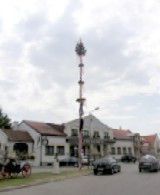 Time
To Put Up Your Maibaum (Maypole): One of the traditions of Germanic Europe is the
Maypole (Maibaum in German), which is typically erected on the eve of April 30 or
during the next day, May 1, and then remains in place for the full month of May. Time
To Put Up Your Maibaum (Maypole): One of the traditions of Germanic Europe is the
Maypole (Maibaum in German), which is typically erected on the eve of April 30 or
during the next day, May 1, and then remains in place for the full month of May. A "classic" Austrian Maibaum is a very tall tree trunk, shaven of all but its highest branches, decorated with ribbons and bows and other items, then erected in the town square. The example at the right comes from Apetlon, Burgenland (2009). Putting up a Maibaum is, of course, a festive occasion, with a procession to escort the tree trunk into town and traditional music, dancing and good food surrounding the preparation and erection of the pole. 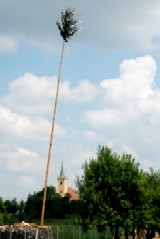 However,
there is another, more personal version of this practice that is sometimes followed; Margaret
Kaiser pointed this out to me this past month... It seems that some young men secretly erect
small decorated Maibäume in front of the houses of their intended sweethearts. Some
attach a red heart with the name of the girl written on it, or longer ribbons with a more
personal message. The young lady must then wait until the end of the month for her father to
take down the tree before she can read her message and learn the name of her suitor. However,
there is another, more personal version of this practice that is sometimes followed; Margaret
Kaiser pointed this out to me this past month... It seems that some young men secretly erect
small decorated Maibäume in front of the houses of their intended sweethearts. Some
attach a red heart with the name of the girl written on it, or longer ribbons with a more
personal message. The young lady must then wait until the end of the month for her father to
take down the tree before she can read her message and learn the name of her suitor.In Hungary, the Maypole is known as the Majus Fa (May Tree) and the personal version is actively utilized by the young men in Szentpéterfa, Hungary, with at least a half dozen Majus Fa popping up around town every year, some of which rival in height what villages erect! When Margaret wrote to me about this, she said "I believe I've heard that it was a point of honor for one town to 'steal' another town's Maibaum. Not the same tale as the romantic version in Sztpeterfa." New Version of FamilySearch.org Launched: One of our primary internet resources for genealogical information has been overhauled and new features have been added. As you may recall, FamilySearch.org is the web presence of FamilySearch International, the genealogical organization sponsored by The Church of Jesus Christ of Latter-day Saints (LDS). The new website version is designed to promote user entry of genealogical data, however, the previous features are still present but are buried a layer deeper. If your interest is to search records, you can click "Search" on their new home page or you can use link https://www.familysearch.org/search to go directly there. In general, if you have saved a link to go directly to something on FamilySearch, that link will still work. While I do not intend to do a full review of the new features in this newsletter, I will note that it flags Internet Explorer 9 (IE-9) as unsupported if Compatibility View is turned on (which causes it to act like IE-8) and recommends upgrading to a different browser; however, so far I have seen nothing that fails to work properly under IE-9. Burgenland Recipes: We continue with recipes reprinted by permission of the Austrian Donau Club in Connecticut. Our thanks to Dennis Kern, President of the club, and (again) to Linda Poglitsch, who provided this recipe! MUSHROOM SOUP (from Linda Poglitsch) (Schwammerlsuppe)  1/2
lb. mushrooms, sliced 1/2
lb. mushrooms, sliced2 Tbsp. butter 1 tsp. onion, chopped 1 tsp. parsley 1 tsp. lemon juice White Sauce: 2 Tbsp. butter 3 Tbsp. flour 1 1/2 qt. water or soup stock 1 1/4 c. sour cream Sauté well-cleaned mushrooms in butter with onion, parsley, and lemon juice. Prepare White Sauce. Boil 10 minutes; add salt and pepper. Add mushrooms and sour cream. Simmer 10 minutes more. White Sauce: Melt butter. Add flour; stir. Add water or soup stock, stirring to boiling point.  Bonus!
A Sachertorte Recipe: Margaret Kaiser passed along a
link to a recipe for Sachertorte, that über-traditional Vienna confection! Interestingly, it
comes from a cruise line... and one might wonder, given the distance of Vienna to an ocean,
why a cruise line would feature Sachertorte, until you note that it was a river cruise line,
Viking River Cruises... and they cruise the Danube so a Viennese treat makes much sense. Here
is their interpretation of this Austrian treasure, first created by Franz Sacher in 1832: Bonus!
A Sachertorte Recipe: Margaret Kaiser passed along a
link to a recipe for Sachertorte, that über-traditional Vienna confection! Interestingly, it
comes from a cruise line... and one might wonder, given the distance of Vienna to an ocean,
why a cruise line would feature Sachertorte, until you note that it was a river cruise line,
Viking River Cruises... and they cruise the Danube so a Viennese treat makes much sense. Here
is their interpretation of this Austrian treasure, first created by Franz Sacher in 1832:Cake Ingredients 5 oz. softened butter 1/2 cup sifted powdered sugar 8 egg yolks 8 egg whites 5 oz. bittersweet chocolate 2/3 cup of flour 1/2 cup sugar 2 Tbsp. apricot jam Glaze Ingredients 8 oz. bittersweet chocolate 2 Tbsp. butter Directions: Preheat oven to 375°F. Cream together butter and powdered sugar. Add 1 egg yolk at a time, mixing until creamy. Melt the 5 oz. bittersweet chocolate in a double boiler or microwave; gradually add to the creamed mixture. Fold in flour. In a separate bowl, beat the egg whites and sugar until stiff. Fold into chocolate mixture. Pour batter into a lined 9-inch springform pan. Bake for 50-65 minutes. Remove from pan and cool on a wire rack. Heat apricot jam and smooth over entire torte, including the sides. For glaze, melt the 8 oz. bittersweet chocolate with butter and frost the cake. Serve with whipped cream. Makes 8-10 servings. 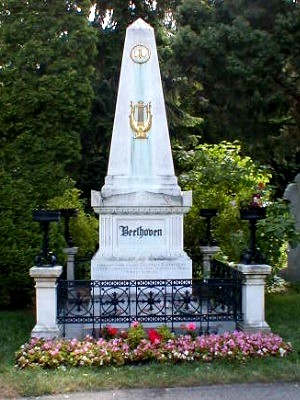 Joke
of the Month: As you may know, Ludwig van Beethoven (1770-1827) was born in Bonn,
Germany (more accurately, in the Electorate of Cologne) but moved to Vienna in 1792 and lived
out his life there. He was buried in the Währing cemetery, northwest of Vienna but, in 1888,
was moved to Vienna's Zentralfriedhof. Although he first gained a reputation as a virtuoso
pianist, he is considered to be one of the most famous and influential of all composers, with
the most important of his 9 symphonies, 5 piano concertos, 32 piano sonatas, 16 string
quartets and other works being composed after his hearing began deteriorating in 1800. Joke
of the Month: As you may know, Ludwig van Beethoven (1770-1827) was born in Bonn,
Germany (more accurately, in the Electorate of Cologne) but moved to Vienna in 1792 and lived
out his life there. He was buried in the Währing cemetery, northwest of Vienna but, in 1888,
was moved to Vienna's Zentralfriedhof. Although he first gained a reputation as a virtuoso
pianist, he is considered to be one of the most famous and influential of all composers, with
the most important of his 9 symphonies, 5 piano concertos, 32 piano sonatas, 16 string
quartets and other works being composed after his hearing began deteriorating in 1800. Despite his remarkable reputation, we are not above telling a joke at his expense... A Viennese was walking around the Zentralfriedhof when he heard music. He asked the old gravedigger where it was coming from and why it was playing, but the gravedigger was not sure; however, he recognized the music as Beethoven's 9th Symphony. When it finished, there was a short pause, then music began again. This time it was Beethoven's 8th Symphony... and the music seemed to be coming from an old but well-known tombstone. At the end of the 8th there was again short pause and then came the start of Beethoven's 7th Symphony. "I've got it!" said the gravedigger, reading the name on the stone, "Beethoven is decomposing." |
2) MARIA HOFFMANN HOTWAGNER Sometimes, in researching one thing, you stumble across something else that is quite interesting yet mostly disconnected from the original research. Such is the case this last month when I became involved with the research of BB Member Florence (Beebe) Hoffman. She was searching for the death date of an aunt of her husband Walter F Hoffman. Said aunt, Maria Hoffmann Hotwagner, was born in Mariasdorf, Oberwart, Burgenland (Mariafalva, Hungary), on July 15, 1878. Maria was one of the 13 children (Johannes, Maria, Josef, Aloysius, Adolf, Ferdinand, Raymund, Carolus, Albina, Robert, Albert, Raymund, and Theresia) of Josef Hoffmann, born 1851, and Maria Mattis, who married Feb 22, 1876. Beebe's husband, Walter, is the son of Albert. What is also known about Maria Hoffmann Hotwagner is that she married Josef Hotwagner (born Feb 21, 1873 in Mariasdorf) on Feb 4, 1902 in Mariasdorf. Then she and her husband emigrated to Chicago, IL, arriving via Ellis Island on March 7, 1902 (the surname was listed as Hodwagner). Their first child, Josef, was born in Chicago on August 2, 1902. The family returned to Hungary in 1908, where their second child, Ferdinand, was born on July 16, 1908. They went yet again to the US, now with their two children, arriving on May 18, 1909, and, according to the US Census, were living in Chicago in 1910. However, at some point they returned to Hungary again, where child number three, Adolph, was born March 10, 1919, in Mariasdorf. Thereafter, it appears they remained in Hungary. As Beebe tells me... 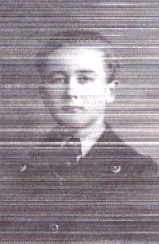 •
Son Josef Hotwagner was a teacher in Kitzladen, Austria, from 1928 until 1938. He died
in a prison hospital, July 3, 1945, in Straübing, Germany. •
Son Josef Hotwagner was a teacher in Kitzladen, Austria, from 1928 until 1938. He died
in a prison hospital, July 3, 1945, in Straübing, Germany.• Son Ferdinand Hotwagner died in 1943, during WW-II, in Saljevo, Bosnia. • Son Adolph Hotwagner died in 1944 in the Ukraine. • She has no idea when Maria Hotwagner died, but... • Maria's grandson, Josef Hotwagner, son of Josef, was the historian of Rechnitz, and he died in 2010. • No mention is made of the fate of Maria's husband, Josef Hotwagner. I became involved with Beebe's research as a result of Angyne Smith's offer (reported in last month's newsletter) to provide some research help to BB Members during a trip she plans to make to Großpetersdorf this summer. Beebe responded, asking for a lookup of Maria's death date but, to my eyes, her request message provided information that was both too imprecise and too limited to expect Angyne to have any success. Beebe believed that Maria died "in the 1900s" and "possibly in Rechnitz", which, as you can see, is a rather wide search target for Angyne, so I started digging deeper and asking for more information. Most of the information I present above comes from Beebe's replies and my personal research. I recently passed along the (supplemented) request to Angyne ...but I also invite any of you, who may recognize this family and know the desired death date, to drop a note to Beebe or me; you'll make her day! Now, though, we get to what the late radio personality Paul Harvey called, "the rest of the story." Almost a year ago, in BB Newsletter 221 (May 31, 2012), I wrote an article about Burgenland's Castles. In it, I wrote (in part) the following about the Rechnitz Castle (actually, a Schloß):
And for Maria's sons Josef and Ferdinand, they paid the ultimate price for kindness to the
persecuted. To make matters worse—if such is possible—Maria also lost her last and youngest
child to the Nazi war. Sad, sad indeed. |
3) A SALZBURG TO BURGENLAND CONNECTION? BB Member Richard Potetz is a participant in Frank Paukowits' Burgenland DNA Project, a project which was launched in February 2011 and has been reported on a number of times in the BB Newsletters (see Newsletters 207, 214 and 219). The last of those three articles is one by Richard wherein he reports a DNA connection found via his personal results. This current article discusses a different connection, one which was pointed out to Richard via DNA but that has also been discussed in the BB Newsletters before: that is, there is reason to believe that some Burgenland families may have come from the Salzburg area when Lutherans were expelled in 1732. [Ed. Note: By the way, there is also another Burgenland DNA project, headed by Henry Sinai, that is targeted at Jewish families from the Sheva Kehillot (Seven Communities) of Burgenland: Eisenstadt, Deutschkreutz, Mattersdorf, Lackenbach, Kobersdorf, Kittsee and Frauenkirchen. Henry provided a short article about the study that was published in Newsletter 206 (Jan 2011). Henry: if you are reading this, we could use an update!] 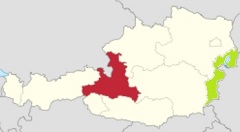 My
purposes in this article is to share Richard's communications on the topic and to expand a
little on the idea of a potential Salzburg/Burgenland connection [Salzburg is shown in red
in the map to the right; Burgenland in green]. I'm doing this because I remain fascinated
by the questions of where the Burgenland people came from and when they came
(especially the German ones, since my Burgenländers were Germanic ...yes, I have my petty
biases!). I also remain frustrated because these questions have resisted almost all efforts to
find solid documentary evidence, even for small groups in Burgenland. My
purposes in this article is to share Richard's communications on the topic and to expand a
little on the idea of a potential Salzburg/Burgenland connection [Salzburg is shown in red
in the map to the right; Burgenland in green]. I'm doing this because I remain fascinated
by the questions of where the Burgenland people came from and when they came
(especially the German ones, since my Burgenländers were Germanic ...yes, I have my petty
biases!). I also remain frustrated because these questions have resisted almost all efforts to
find solid documentary evidence, even for small groups in Burgenland. It is, however, evident that there is no single source territory where emigrants came from nor a single time period that they arrived in, but it would be nice to see strong evidence for the movement of at least some groups of Germanic people in some time period! I begin with Richard's message to Frank Paukowits and myself, plus the part of his exchange with Catherine Pendleton that he shared with us. Richard Potetz writes: Hi Frank and Tom, FYI there is one DNA link that supports the movement of people from the Salzburg area to Burgenland in not too distant times. One of the 240 people linked to me on the 23andme site has hypothesized our connection may come through the 1732 Salzburg dispersion that Gerry Berghold wrote about in 1999. The Wikipedia article on Salzburg (http://en.wikipedia.org/wiki/Salzburg) mentions refugees settling in both Hungary and the US. The person who contacted me is descended from people who dispersed to Georgia. Her message to me has a link to the Georgia Salzburger Society website. This DNA link is unsupported by genealogical evidence, but if either of you knows of a Burgenland connection to Salzburg please let me know. I have no evidence at all. The Ziegar name located in Oberdrossen that is in my tree existed there in the 1720 Urbarium (before 1732). I’ve appended messages exchanged on the 23andme site below. It starts with a message from the mother of the person tested on 23andme, who is responding to my profile that asks persons linked to me via DNA to contact me if they have Burgenland or Austrian/Hungarian/Slovenian ancestors. Catherine Pendleton writes to Richard: Hi Richard, this is Catherine Pendleton, Kathleen's mom. I handle her account. She has ancestors on both her maternal and paternal side who were from modern-day Austria. According to the Georgia Salzburger Society website http://www.georgiasalzburgers.com/, the Salzburgers, as this group was called, landed in Savannah Georgia in 1734. Here are some surnames in Kathleen's family that were part of the Salzburger group. I may have missed some: Maternal side: Dasher, Treutlin, Waldhauer, Zeigler, Densler, Floerl Paternal side: Lineberger, Seckinger, Zipperer, Schneider I looked through your surnames on your profile but didn't [see] any that we share, although Zeiger is close in spelling to Zeigler. One of Kathleen's lines married into the Wisenbaker family (another Salzburger family), which is close in spelling to Wischenbart. Note: Joseph W. Lineberger (on 18 Dec 2017) provided the original names of two of the above families, specifically Dasher and Lineberger. He writes: Dasher was originally spelled Tascher and they were not from Salzburg state but from Germany. They came later and settled in the Salzburger settlement of Ebenezer in the Georgia colony. Lineberger is an anglicized version of Leimberger. Christian Leimberger, my ancestor, was from Leogang [in Salzburg] and came over on the 1st Transport of Salzburgers to Georgia. Richard responded to Catherine: Hi Catherine, thank you very much for the information. In an article written in 1999, the editor of the Burgenland Bunch Newsletter, Gerald Berghold, thought Salzburg immigration to Burgenland to be probable as follows:
(The Batthyány referred to by Gerald was the aristocratic family that owned all of the
estates in the place that became southern Burgenland.) It also indicates that Austria had noted what Salzburg had done and "decided it would be
better to use the pesky Protestants to populate their own distant borders, especially in lands
facing the Turkish threat such as Transylvania and the mid-Danube and on into Hungary. There,
they would not only be useful as cannon fodder, they might rejuvenate arid and barren lands
and make some money for the empire." Thus areas in central and eastern Austria were also
cleansed, with the Protestants shipped further east. Whether some of these stopped just over
the border into Hungary is not indicated or even implied. |
4) THE BRIDGE AT ANDAU (by Hannes Graf) We have been republishing some articles Hannes wrote over the past two years for placement on his personal site, Spirit of Gradišće - Őrvidék Group. This month, we are presenting an article about the famous Bridge at Andau, a route across the Hungarian border. 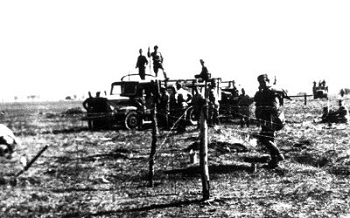 On
October 23rd, 1956, a national uprising broke out in Hungary. This uprising was put down by
the Soviet troops on November 5th. Over 200,000 Hungarians fled the country. The bridge at
Andau, at that time, was indeed the last possible way into freedom for many. On
October 23rd, 1956, a national uprising broke out in Hungary. This uprising was put down by
the Soviet troops on November 5th. Over 200,000 Hungarians fled the country. The bridge at
Andau, at that time, was indeed the last possible way into freedom for many.The late American, best-selling author James A. Michener had then been "reporter on the spot." Thereafter, he wrote a book about the dramatic events, entitled "The Bridge at Andau." This was, Michener writes, possibly the least important bridge in Europe. But the twist of fate would have it become one of the most important bridges in the world for a couple of weeks. The Andau chronicle tells you about these events: 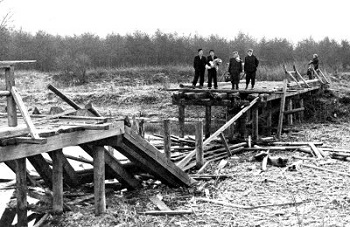 On
Sunday, November 4th, the roar of tank engines and the rattling of the chains of armored
vehicles approaching the national border was in the air. The people held their breath,
wondering what would happen. Our firefighters went to the border and marked it with
red-white-red flags. ... In the next few days the first refugees arrived. From day to day, the
flow of refugees swelled. Thousands came from all over Hungary via the Einser channel to
Andau, into the freedom of the West. On
Sunday, November 4th, the roar of tank engines and the rattling of the chains of armored
vehicles approaching the national border was in the air. The people held their breath,
wondering what would happen. Our firefighters went to the border and marked it with
red-white-red flags. ... In the next few days the first refugees arrived. From day to day, the
flow of refugees swelled. Thousands came from all over Hungary via the Einser channel to
Andau, into the freedom of the West.This small, insignificant and yet world-famous Andau Bridge had been blown up a little bit later. Shortly before Christmas 1956, the future U.S. President Richard Nixon came as the then Commissioner for Refugees to Andau to get a picture of this refugee disaster. The population of Andau had been in continuous use for the refugees. Here again, the local chronicle: The municipality and the people of Andau accomplished great humanitarian work in those days and weeks, which today would be impossible to imagine. The schools, the kindergarten, the cinema and all public spaces have been provided for the accommodation of refugees. Today the "Bridge at Andau" stands again. It is not only a monument that commemorates the ill-fated times of a divided Europe but also a symbol of helpfulness, tolerance and togetherness across all political boundaries. 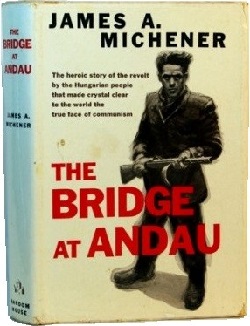 James
A. Michener: "If I ever had to flee, so I hope that it can be to Austria." James
A. Michener: "If I ever had to flee, so I hope that it can be to Austria."Text excerpts from James A. Michener's book "The Bridge at Andau:" At Andau there was a bridge. Could someone reach it, he found the way into freedom. Only an insignificant bridge, neither wide enough for a car nor strong enough for a motorcycle. It's rickety ..... Those generations who had once built this bridge could not, of course, know the role this bridge of simple planks and beams will play one day.... They came out of the reeds of the marsh land, from the mud and the dirt, right across the swamps and via the Einser channel, across the bridge with the rickety beams. Yes, that's the way they came. Then we heard a dull bang, but nothing was to be seen. A refugee, who had kept hidden until then, took his opportunity. Breathless he came running towards us: "They have blown up the bridge!" On November 21, 1956, the bridge was blasted by Soviet troops. |
5) MORE ACCESS RESTRICTIONS FOR US VITAL RECORDS? Dick Eastman, editor/author of Eastman's Online Genealogy Newsletter, recently posted a note concerning an attempt by Oregon legislators to further restrict access to Oregon's birth, marriage, and death certificates. Current Oregon law allows public access to death records after 50 years, marriage records after 75 years, and birth records after 100 years, elapsed times I personally consider to be quite adequate for providing personal privacy and avoidance of identity theft (with the exception of the too-long death interval). However, the proposed legislation will add 25 years to each of the current restrictions; only then will the records will be considered "historical" and open to the public (for substantial fees, of course). Like the current rules, the proposed rules will not apply to "the subject of the record; spouse, child, parent, sibling or legal guardian of the subject of the record; an authorized representative of the subject of the record, spouse, child, parent, sibling or legal guardian of the subject of the record; and, in the case of death, marriage or divorce records, to other next of kin." Those individuals may obtain copies at any time (again, for a fee). The legislation in question is Oregon House Bill 2093. Unfortunately, the deadline for public input was April 8th, so there is nothing out-of-staters can now do to influence the bill... those of you living in Oregon can, of course, contact your legislator and express your opinion. Given that Eastman's Online Genealogy Newsletter is online, it has a place for people to comment on articles. Among the many responses to Dick's post was one noting that Texas is considering quite similar legislative changes... and that led me to question why these two states are acting seemingly in concert. The answer, apparently, is that there is a new, though not yet endorsed, draft 2011 "Model State Vital Statistics Act" that was developed by the Department of Health and Human Services' Center for Disease Control and Prevention (CDC). That proposed Act changes the recommended access restrictions from the previous 100 years for birth records and 50 years for death, marriage, and divorce records. The currently adopted version is from 1992, and many state vital records registrars operate under it based on its adoption by their state legislatures. However, despite the 2011 draft Act being not yet approved, some state legislators are proposing new state regulations based on the assumption that the draft 2011 Act will be endorsed and promulgated. A little background: A Working Group, consisting primarily of state and local vital statistics executives, was formed in 2009 to update the Model Act and, after distributing a draft to vital records officers for comments in 2011, reported out their work as the 2011 Revision in May 2011. However, the Department of Health and Human Services (HHS) put the 2011 Revision “on hold” in April 2012. In June 2011, the National Association for Public Health Statistics and Information Systems (NAPHSIS) endorsed the 2011 Revision and encouraged state vital registration executives to introduce legislation which supported the 2011 Draft Revision. Interestingly, the draft was never distributed to the genealogical community for comment, despite the fact that the community has a vested interest in the rules and has participated in past guideline-setting activities.  One
group who has been quite active is RPAC, the Records Preservation and Access Committee,
which is a joint committee of the Federation of Genealogical Societies, the National
Genealogical Society, and the International Association of Jewish Genealogical Societies. When
RPAC became aware of the 2011 Revision, it contacted the Department of Health and Human
Services and requested that, prior to adoption, the proposed 2011 Revised Model Act should be
made available for public review and comment... that has yet to happen, however. One
group who has been quite active is RPAC, the Records Preservation and Access Committee,
which is a joint committee of the Federation of Genealogical Societies, the National
Genealogical Society, and the International Association of Jewish Genealogical Societies. When
RPAC became aware of the 2011 Revision, it contacted the Department of Health and Human
Services and requested that, prior to adoption, the proposed 2011 Revised Model Act should be
made available for public review and comment... that has yet to happen, however.Meanwhile, RPAC says it has responded to each state initiative when they became aware of the pending legislation. They also say they expect that additional restrictive legislation may be introduced in other states during current legislative sessions, all being based on this unapproved Draft Revision. These bills are often introduced under the guise of “privacy” legislation. However, because states do not have to follow the draft 2011 Revised Model Act, there are opportunities to influence the outcome. So why are the "rules" becoming more restrictive? Clearly, the motivations are multi-facetted and there are valid arguments for some restrictions (as noted above, I personally believe a certain level of access restriction is appropriate... but I do not believe that adding 25 more years to the current recommendations is beneficial). Advocates cite personal privacy and making it more difficult for identity thieves as the major reasons for adding 25 years. One can legitimately argue that some people do live more than 100 years, or 50 years beyond a marriage or divorce, but is there much value in hiding the official record of these events when they are unofficially but routinely published in newspapers when they occur? Likewise, what value is there in hiding the official death record for 50 (or more) years when obituaries are routinely published online and in newspapers? Actually, hiding a death record, for at least a few years, makes some sense. As you may have read recently or seen on television, identity thieves are stealing social security numbers from both living and recently deceased taxpayers and are filing false Federal tax returns—returns doctored to result in large refunds, whether appropriate or not—and they are obtaining substantial amounts. When the real taxpayer or the executor of an estate files later, their return is rejected, and it can take years to get this straightened out. The thieves use names and social security numbers found in the SSDI (Social Security Death Index), or simply steal them from living taxpayers (the Tampa Florida police department has been very hard hit by this). So, a short moratorium on access to death records, say two to five years, makes some sense. One could also argue that death records for infants or young adults be more restricted than for old people, as the young are frequent targets for "regular" identity thieves (in fact, I suspect that this is the primary argument for the current 50-year waiting period). I mentioned the Social Security Death Index (SSDI) above... you should also know that there are also proposals to further restrict access to the SSDI. In fact, in the 2011-2012 Congressional session, several bills on identity theft were introduced and hearings were held in both the House and Senate. Curiously, the genealogical community was considered one of the “culprits” for its use of the SSDI! Clearly there are representatives and senators who are rather confused about genealogical interest in vital data. I should mention that RPACs stated mission is "to advise the genealogical community on ensuring proper access to historical records of genealogical value in whatever media they are recorded, on means to affect legislation, and on supporting strong records preservation policies and practices." As they note, records are always at risk of accidental or scheduled destruction and there are many additional problems which threaten access to the documents and collections that hold our genealogical, medical, and social history. Funding cuts resulting from budget crises, large scale natural disasters, as well as rapidly changing technology are adding to the existing problems of preserving and maintaining access to records. RPAC says it alone cannot solve all these complex issues so acts to help coordinate the efforts of individuals and societies, who can have a tremendous impact on these problems. As they say, the most effective responses to access and preservation challenges are usually by individuals who vote and pay taxes in the specific locality. That is, YOU, individually, and the genealogical societies of which YOU are a member, can make a difference on these issues in your area. |
6) HISTORICAL BB NEWSLETTER ARTICLES Editor: This is part of our series designed to recycle interesting articles from the BB Newsletters of 10 years ago. This month, I reprint one from NL 16 (Aug 1, 1997), as I did not find anything that "tickled my fancy" from April 2003. Perhaps that need, to "tickle my fancy," led me to chose the article below. It represents a rather early emigration (1880) into Kansas, which was not a large destination for Burgenländers, but I think it represents well the nature of that early emigration: whole northern Burgenland farm families (rather than the young, southern Burgenland itinerant factory workers of the later emigrations), to heartland farmland (rather than cities), and with no intent to return to Burgenland. I supplement the original article with a little supporting information. THE BURGENLAND BUNCH NEWS No. 16 August 1, 1997 BURGENLÄNDERS WHO WENT WEST! (from Lynette Wolf) This is a clipping my aunt had from a Rawlins County, Kansas newspaper:
|
7) ETHNIC EVENTS LEHIGH VALLEY, PA (courtesy of Bob Strauch) Saturday, May 4: Maibaumtanz/May Pole Dance at the Coplay Sängerbund. Entertainment by the Coplay Sängerbund Chorus and the Joe Weber Orchestra. Saturday, May 4: Anniversary Concert of the Lehigh Sängerbund Chorus at Muhlenberg College in Allentown. Info: www.lehighsaengerbund.org Sunday, May 5: Maifest with the Reading Liederkranz Singers at St. John's Lutheran Church in Reading. Live broadcast on WEEU Radio 830AM at 11 AM. Info: www.readingliederkranz.com Sunday, May 26: German-Austrian Day at Mayfair at the Allentown Fairgrounds. Sponsored by the Lehigh Sängerbund. Music by the Joe Weber Orchestra and singers from local German-Austrian choruses. Info: www.mayfairfestival.org LANCASTER, PA Tuesday, May 7, 5:30 to 7:30 pm: First Tuesday Buffet (Members $10 - Guests $14). Lancaster Liederkranz. Entertainment by Carl Heidlauf. Saturday, May 11, 7:30 to 11:30 pm: Maitanz (Members $8 - Guests $10). Lancaster Liederkranz. Music by Joe Kroboth Band. Dinner service available 5:30 to 8 pm. NEW BRITAIN, CT Friday, May 3, 7 pm: Heimat Abend. Austrian Donau Club, 545 Arch Street, New Britain, CT (860 223-9401). Music by Joe Rogers. Friday, May 17, 7 pm: Heurigan Abend. Austrian Donau Club. Music by Schachtelgebirger Musikanten. |
8) BURGENLAND EMIGRANT OBITUARIES (courtesy of Bob Strauch) Gisela Weber  Gisela
Weber, 83, of Cassopolis, Michigan, died peacefully early Wednesday morning in her residence. Gisela
Weber, 83, of Cassopolis, Michigan, died peacefully early Wednesday morning in her residence.
Gisela was born September 28, 1929 in Krottendorf (bei Neuhaus am Klausenbach), Austria to the late Johann and Maria (Koller) Weber. Gisela definitely loved her grandchildren. She was passionate about her Catholic faith and regularly attended Mass. She loved the ocean and she loved to dance. Gisela will be greatly missed by family and friends. She is survived by two daughters, Theresia Harrison of Cassopolis and Patricia Burdick of Connecticut; three grandchildren, Jessica (Ronald, Jr.) Christopher of Cassopolis, Eddie (Angela) Harrison of Constantine, and Matthew Burdick of Connecticut; five great-grandchildren, Hailey Christopher, Ronald Christopher III, Cody Harrison, Tyler Harrison, and Alexis Harrison; and several siblings in Austria. Family and friends will gather at 11:00 a.m. Saturday, April 13, 2013, at the Graveside in Prospect Hill Cemetery, Cassopolis, with the Reverend Fr. Donald G. Potts officiating. Arrangements have been entrusted to Connelly Chapel Wagner Family Funerals, Cassopolis. Please share a memory or a message online: wagnercares.com. Published in South Bend Tribune on April 12, 2013 Anna (Sucher) Potetz  Anna
(Sucher) Potetz, 95, of New Britain died Thursday (April 4, 2013) at the Hospital of Central
Connecticut in New Britain. Born in Wartegg, Austria, she came to the United States in 1935.
She was the wife of the late Michael Potetz for 44 years. She worked at various local
factories and as a domestic for many years. A member of St. Peter Church and the Ladies Guild
of the Church, Mrs. Potetz will be remembered as a compassionate, wise and hard-working person
with a fondness for animals. She shared vegetables from her garden, grew beautiful flowers and
made Christmas cookies beyond compare. Anna
(Sucher) Potetz, 95, of New Britain died Thursday (April 4, 2013) at the Hospital of Central
Connecticut in New Britain. Born in Wartegg, Austria, she came to the United States in 1935.
She was the wife of the late Michael Potetz for 44 years. She worked at various local
factories and as a domestic for many years. A member of St. Peter Church and the Ladies Guild
of the Church, Mrs. Potetz will be remembered as a compassionate, wise and hard-working person
with a fondness for animals. She shared vegetables from her garden, grew beautiful flowers and
made Christmas cookies beyond compare.Mrs. Potetz is survived by her daughter, Lisa Potetz of Chevy Chase, Md., her son, Richard and his wife, Jean M. Potetz, of West Granby; two grandchildren, Brian Potetz and Andrea Wysocki; two great-grandchildren and many nieces and nephews. In addition to her husband, she is predeceased by her son, Michael J. Potetz. Funeral services will be held Saturday with a Mass of Christian Burial at 9 a.m. at St. Peter Church. Burial will follow in St. Mary Cemetery, New Britain. Visitation will be Saturday from 8 a.m. until the time of the Mass at the Farrell Funeral Home, 110 Franklin Square, New Britain. In lieu of flowers, donations may be made to Wolfson Palliative Care, c/o the Hospital of Central Connecticut, 100 Grand St., New Britain, CT 06050 or to the Jerome Home, 975 Corbin Ave., New Britain, CT 06052. To light a candle or send a condolence, please visit www.FarrellFuneralHome.com. Published in the New Britain Herald on April 15, 2013 Helen Kurcz  Helen
Kurcz (née Sakovits), age 90, of Buffalo, New York, passed away April 22, 2013. She was the
beloved wife of the late Joseph Kurcz. Helen
Kurcz (née Sakovits), age 90, of Buffalo, New York, passed away April 22, 2013. She was the
beloved wife of the late Joseph Kurcz.Born in Szentpéterfa (Petrovo Selo/Prostrum), Hungary, she was a daughter of the late Jozsef and Katalin (Dancs) Sakovits. Survivors: children, Joseph (Diane) Kurcz, Roza Kurcz, Helen Kurcz and Linda Kurcz; grandchildren, Kelly (Robert) Ruffner, Roza Quinn, Dawn Kurcz and Joseph Kurcz; great-grandchildren Scott, Zachary, Sarah, Harrison, Grace, Olivia and Caroline; nieces and nephews. She was predeceased by brothers and sisters in Hungary. Services: the family will be present on Wednesday from 4-7 PM at the Quinn-AMIGONE FUNERAL HOME, 192 Abbott Rd. (near South Park), where prayers will be offered on Thursday at 8:15 AM, followed by a Mass of Christian Burial to be celebrated from Our Lady of Bistrica at 9 AM. Flowers gratefully declined. If so desired, memorials may be made in Mrs. Kurcz's name to Hospice-Buffalo, Inc. Please share your condolences at www.AMIGONE.com |
END OF NEWSLETTER |
NOTICE (Terms and Conditions): The Burgenland Bunch (BB) was formed and exists to assist Burgenland descendants in their research into their heritage and, toward that end, reserves the right to use any communication you have with us (email, letter, phone conversation, etc.) as part of our information exchange and educational research efforts. • If you do not want your communication to be used for this purpose, indicate that it is "confidential" and we will abide by that request. • Correspondents who communicate with the BB without requesting confidentiality retain their copyright but give a non-exclusive license to the BB allowing us to forward to BB members, publish in our monthly newsletter or on our website, and/or subsequently and permanently archive all or parts of such communications. The Burgenland Bunch homepage (website) can be found at: http://www.the-burgenland-bunch.org/ Burgenland Bunch Newsletter, copyright © 2013 by The Burgenland Bunch All rights reserved. Permission to copy excerpts granted if credit is provided. |
 News
News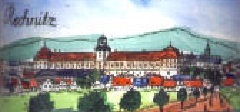 The
castle proper was completely destroyed when the Red Army overran the town and the
surrounding area during the night of 29 March 1945. Although the Russians were blamed for
setting the castle ablaze, many townspeople believe it was the German forces who torched it
in compliance with Hitler's scorched earth policy. The surviving private chapel suffered the
ignominy of being converted into a bar and other buildings into apartments.
The
castle proper was completely destroyed when the Red Army overran the town and the
surrounding area during the night of 29 March 1945. Although the Russians were blamed for
setting the castle ablaze, many townspeople believe it was the German forces who torched it
in compliance with Hitler's scorched earth policy. The surviving private chapel suffered the
ignominy of being converted into a bar and other buildings into apartments.  What
I did not know when I wrote that text, is that much of the atrocity story is known due to the
research of Maria's grandson, Josef Hotwagner, who was 8 at the time. As you might expect, the
participants in the atrocity did their best to cover it up.
What
I did not know when I wrote that text, is that much of the atrocity story is known due to the
research of Maria's grandson, Josef Hotwagner, who was 8 at the time. As you might expect, the
participants in the atrocity did their best to cover it up.
 To
this day, the site of the final resting place of the bodies is unknown, though the shootings
took place at the Kreuzstadel (cross barn) on the edge of town, where a small group of
Jewish prisoners were forced to dig a large pit. Truckloads of additional prisoners were
brought there, forced to strip and kneel on the edge of the pit, then were shot in the neck by
party guests. The Kreuzstadel is now a monument to commemorate the massacre. However,
no mass grave has ever been found there, despite repeated research efforts.
To
this day, the site of the final resting place of the bodies is unknown, though the shootings
took place at the Kreuzstadel (cross barn) on the edge of town, where a small group of
Jewish prisoners were forced to dig a large pit. Truckloads of additional prisoners were
brought there, forced to strip and kneel on the edge of the pit, then were shot in the neck by
party guests. The Kreuzstadel is now a monument to commemorate the massacre. However,
no mass grave has ever been found there, despite repeated research efforts.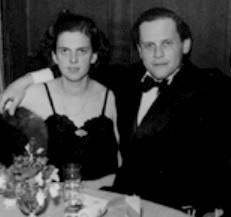 Margit
Thyssen, who died in 1989, skipped off to Switzerland immediately after, and insufficient
evidence has been produced to prove that she participated. However, her nephew, Sacha
Batthyány, who knew her well, titles her a "monster" and says she loved shooting and horses
over everything else, even her own children. Sacha also wrote that, although the massacre was
known of within the family, it was not a subject that could ever be discussed, especially
since Margit controlled the family fortune.
Margit
Thyssen, who died in 1989, skipped off to Switzerland immediately after, and insufficient
evidence has been produced to prove that she participated. However, her nephew, Sacha
Batthyány, who knew her well, titles her a "monster" and says she loved shooting and horses
over everything else, even her own children. Sacha also wrote that, although the massacre was
known of within the family, it was not a subject that could ever be discussed, especially
since Margit controlled the family fortune.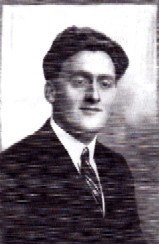 The
historian Josef Hotwagner, son of the Josef above, and Wilhelm Gregorich
(see below) report the story more fully... Josef's father was the head of the primary school
in Kitzladen until 1938, but was demoted several times thereafter by the Nazi regime, largely
because he could speak Hungarian, first to St. Martin and then to Schachendorf as a simple
teacher.
The
historian Josef Hotwagner, son of the Josef above, and Wilhelm Gregorich
(see below) report the story more fully... Josef's father was the head of the primary school
in Kitzladen until 1938, but was demoted several times thereafter by the Nazi regime, largely
because he could speak Hungarian, first to St. Martin and then to Schachendorf as a simple
teacher. Meanwhile,
Wilhelm Gregorich, a teacher in Oberwart, spoke a few kind words at a funeral in memory of the
village priest, who had died shortly after the Anschluß. Wilhelm was reported as a
"friend of the church"—therefore as a Nazi opponent—and sent to a disciplinary unit in the
summer of 1938. By 1940, he was allowed to return as a teacher in Schandorf, but the teacher's
apartment was occupied so he moved to Rechnitz, where he got to know fellow teacher Josef
Hotwagner. One summer day in 1940, they were together and returning home from church when they
met Imre Kiss, a Nazi opponent. Imre was collecting money for the families of 30 men
incarcerated in Pinkafeld, saying that their wives and children have nothing. Gregorich and
Hotwagner each gave five marks. However, the transaction was observed and they were eventually
betrayed by another teacher.
Meanwhile,
Wilhelm Gregorich, a teacher in Oberwart, spoke a few kind words at a funeral in memory of the
village priest, who had died shortly after the Anschluß. Wilhelm was reported as a
"friend of the church"—therefore as a Nazi opponent—and sent to a disciplinary unit in the
summer of 1938. By 1940, he was allowed to return as a teacher in Schandorf, but the teacher's
apartment was occupied so he moved to Rechnitz, where he got to know fellow teacher Josef
Hotwagner. One summer day in 1940, they were together and returning home from church when they
met Imre Kiss, a Nazi opponent. Imre was collecting money for the families of 30 men
incarcerated in Pinkafeld, saying that their wives and children have nothing. Gregorich and
Hotwagner each gave five marks. However, the transaction was observed and they were eventually
betrayed by another teacher.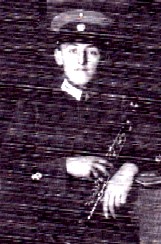 Josef's
younger brother, Ferdinand Hotwagner, a postman in Pinkafeld, was also arrested because he
donated money for the persecuted in Oberwart and Pinkafeld. Since he was previously a musician
in the Austrian Army, he was given a choice: either face trial or go into the Army again. He
opted for the Army and was assigned to a disciplinary unit; he was soon in Sarajevo, where he
died.
Josef's
younger brother, Ferdinand Hotwagner, a postman in Pinkafeld, was also arrested because he
donated money for the persecuted in Oberwart and Pinkafeld. Since he was previously a musician
in the Austrian Army, he was given a choice: either face trial or go into the Army again. He
opted for the Army and was assigned to a disciplinary unit; he was soon in Sarajevo, where he
died.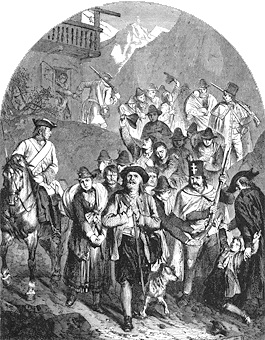
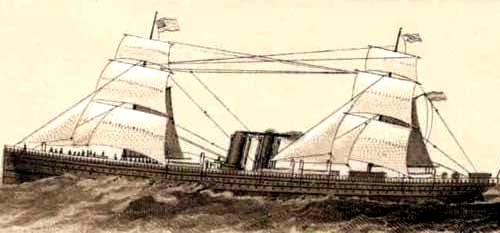 From
Ship Passenger Lists
From
Ship Passenger Lists The
religious needs of Herndon people continue to be served by St. Mary's Assumption Catholic
Church (1917) and the Immanuel United Church of Christ. Both had their beginnings in the late
19th century. A third church, the German Congregational Church also started up in those times
but fell by the wayside after a few years of existence.
The
religious needs of Herndon people continue to be served by St. Mary's Assumption Catholic
Church (1917) and the Immanuel United Church of Christ. Both had their beginnings in the late
19th century. A third church, the German Congregational Church also started up in those times
but fell by the wayside after a few years of existence.